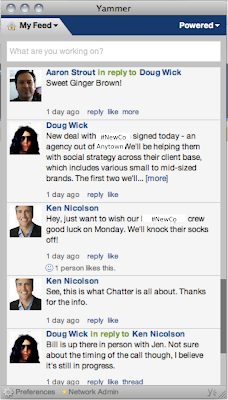If you follow my
Twitter stream or listen to my
weekly podcast, you'll know that the question of whether I think FourSquare and Gowalla are shiny objects is a loaded one. Of course I am bullish on the value
location-based services like
FourSquare,
Gowalla offer large and small businesses alike. Truth be told, however, I've had a hard time telling clients and prospective clients alike that it's time to go guns a blazing with location-based services for two reasons:

- There's not enough critical mass... YET
- Facebook with it's 450 million users could come in and crush both FourSquare (~2 million members) and Gowalla (~1 million members) in a New York minute if it decides to get serious about geolocation
With that said, that doesn't mean that I don't think companies shouldn't be starting to think about how to incorporate location-based services into their marketing and social media mixes. Fortunately, there are a number of big brands that are already starting to test location-based services (more FourSquare than Gowalla). TO that end, I've provided a list of the companies experimenting with Foursquare below [list is courtesy of
David Stutts with a hat tip to the folks at
SocialPath for pointing this work out).
- Starbucks (side note: I'd like to think my wife and I played a role in Starbucks launching this one)
- The Bravo Network
- Dominoes Pizza UK (I like this one a lot)
- Jimmy Choo
- Pepsi (interesting note on this one later in the post)
- Zagat (this is a no brainer IMHO)
- Warner Brothers
- Tasti D-lite (what they are doing is very smart)
- The Wall Street Journal
- Marc Jacobs
- Coach Men's Store
- The Financial Times
- HBO
- Harvard (sounds like fun)
- Metro
- VH1
- Pennsylvania Tourism
- History Channel
- Planet Hollywood Las Vegas
- Huffington Post (not using FourSquare but mimicking what they are doing)
And here is the presentation on SlideShare that David put together. Click through to get the details on each program.

So we've seen who is experimenting with location-based services like FourSquare but let's take a step back and look at why companies might want to engage in location-based services.
Loyalty
At the end of the day, location-based services like FourSquare and Gowalla are ultimately going to be best at creating long-term loyalty with existing customers. Companies like Tasti D-Lite have started to figured this out by feeding their reward programs through point of purchase experiences which in turn check users into social sites like
Twitter and FourSquare. And when a customer checks in, he/she earn points toward free food/drinks.
Let's be honest, while it's nice to earn frequent flier or hotel points, the act of earning them isn't all that exciting. Yet earning bragging rights by becoming mayor or even showing off the fact that you are buying jeans at that cool new boutique downtown is much more fun. As a business, incentivizing more checkins and thus more opportunities to buy stuff and share that experience with your customers' networks has nothing but upside for your top and bottom lines.
Discovery
One of the things I like most about FourSquare from a personal perspective is the discovery element -- both in terms of places and people. As someone that is still feeling his way around Austin, TX, I love watching colleagues like
Natanya Anderson (big time foodie),
Doug Wick and
Kathy Warren alert me to good places to get a meal, watch a game or grab breakfast tacos to go. It's also useful if I'm at a conference or sporting event to see where my friends are. Even if we're not connected, many people cross-post their FourSquare and Gowalla status to their Facebook and Twitter pages.
Discovery also comes into play with people. If I'm at my local coffee joint, it's fun to know who else frequents it. In some cases, it can lead to fun connections that one wouldn't normally make. As an example several months ago my now friend,
Jenna Oltersdorf, noticed that I was the mayor of her local
Starbucks. Curious as to who the person was who laid claim to such an honor, she reached out to me via Twitter and asked if I'd like to grab coffee sometime (at that Starbucks of course). In related fashion, my colleague,
Joe Jaffe, tells a similar story of him bumping into a prospective customer at a restaurant in San Francisco while seeking out the mayor.
Reach and Referrals
The win here is that while customers are working to accumulate points, bragging rights or free stuff by checking into your store on location-based services like FourSquare and Gowalla, they are also sharing you with their network. Better than that, they are also implicitly (and sometimes explicitly) endorsing you by letting others know they patronize your establishment. Think about the power of running a promotion where anyone that checks into your store more than three times over the course of a month gets a one day discount of 25% off all merchandise. In doing so, you've created a reason for customers to 1) visit your store multiple times and 2) let their friends know about it when they do.
Hurdles
Before I get you too hot and bothered, there are few additional obstacles that need to be overcome before location-based services really take off:
- Scale - while location-based services are growing rapidly, they still only represent a few million people at best. This could change in a hurry if Facebook gets serious about location-based services but in the immediate future, it's really the early adopters that are leading the charge.
[POST SCRIPT: in publishing the post, I forgot to pay off the "Pepsi" reference above... several weeks ago, I had a hallway conversation with Bonin Bough, director of social media for Pepsi. We were talking about LBS and I told him my theory about Facebook swooping in and crushing FourSquare and Gowalla. He said that he didn't see it that way and that his bet was on someone like FourSquare that truly embraced business and a desire to help them succeed would ultimately win. This was later confirmed when Pepsi announced that they were partnering with FourSquare as noted above]
Potential impact on growth = BIG
- Gaming the system - it is still possible to check into a location without physically being in that location. However, Gowalla has always been a stickler about GPS proximity to a location (to a fault when they first launched) and now FourSquare has followed suit by announcing that you can only accumulate points AND earn mayorships by being within a certain proximity of where the location was originally created.
Potential impact on growth = SMALL
- Privacy - this is a tricky one. More and more people (including myself) are becoming increasingly aware about whom they tell about what they are doing. I think the way LBS providers overcome this is to increase the security and the privacy around who can see what and when.
Potential impact on growth = TBD
- Pain in the ass factor = while checking in can be fun, it also requires a conscious effort that can sometimes take up to 3-4 minutes to accomplish. This is particularly awkward when you are meeting friends out and they have to wait for you to check in before they can talk to you. My belief is that location-based services over time will allow you to preset places that you frequent (similar to wireless spots that you've connected to in the past on your laptop or smart phone) that will auto-check you in. This would go a long way in increasing the checkins by customers with a lot less aggravation.
Potential impact on growth = SMALL
Summary
While there are obstacles that could stand in the way of companies adopting location-based services, I am a firm believer that the rewards far outweigh the risks. In fact, if someone were to give me a truth serum and demand that I tell them what the next "big thing" was, I'd be hard pressed to not say location-based services. Don't take my word for it though. Instead, keep your eye on the twenty companies mentioned in David Stutts SlideShare presentation above and see if they continue to embrace these new tools.
What do you think? Am I living in my own universe? Feel free to tell me how you feel about the future of location-based services in the comments below.
 To be honest, it's always easier to market a company that has great content and fortunately the company she is working for has great content in spades. It's also makes it easy when a company hands you the reigns (with some guidance of course) but doesn't give you eight billion rules and regulations that you need to follow (I know, I know... I worked in financial services for nine years... some companies need to be strict about how they market... but still).
To be honest, it's always easier to market a company that has great content and fortunately the company she is working for has great content in spades. It's also makes it easy when a company hands you the reigns (with some guidance of course) but doesn't give you eight billion rules and regulations that you need to follow (I know, I know... I worked in financial services for nine years... some companies need to be strict about how they market... but still).










